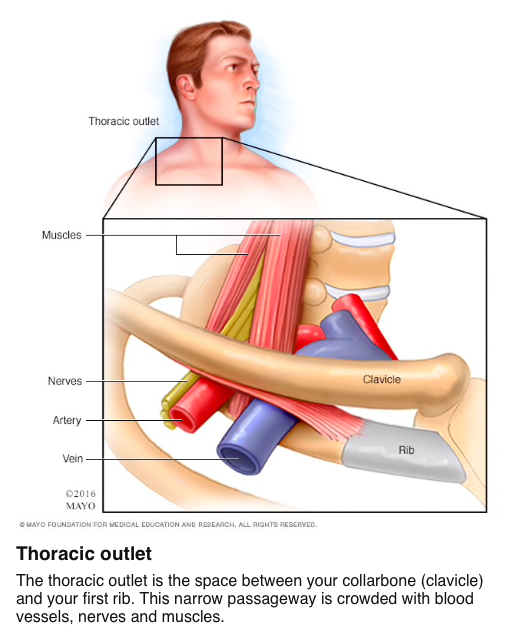
Thoracic Outlet Syndrome
Are you experiencing pain, altered sensation or heaviness in your arm? It could be thoracic outlet syndrome.
Thoracic outlet syndromes (TOS) are a group of conditions that occur when there is compression or irritation to the nerves or blood vessels as they pass through the ‘thoracic outlet’, or as they travel from your neck towards your armpit. The brachial plexus, which is the bundle of nerves that supply the upper body and the subclavian vessels (vein and artery) run through the outlet. It is more common in women, and people 20-50 years old.

Signs and Symptoms
Thoracic outlet syndrome can present with symptoms of either nerve or blood vessel compression, or a combination of both. Nerve compression is the most common and usually presents with pain, altered sensation, weakness, and occasionally loss of muscle tone in the arm. The venous type results in swelling, pain, and change of circulation leading to sweating, blue tinged discoloured skin and blotchiness of the arm. The arterial type results in pain, coldness, and paleness of the arm. These might be happening individually or together.
What causes Thoracic Outlet Syndrome?
- Compression of nerves or arteries due to tight muscles
- Injury to the artery due to bony abnormality
- Injury or compression of the vein.
- Trauma
- Repetitive arm movements causing hypertonic neck and chest muscles
- A congenital abnormality
- Tumour
- Pregnancy
How can osteopathy help?
- Our osteopaths will complete a full assessment, diagnosis and management plan for your symptoms
- We have specific tests we can use to determine if it is thoracic outlet syndrome or other conditions causing your symptoms.
- We can use techniques like soft tissues, joint mobilization and stretching to help reduce muscle tension around the thoracic outlet
- These techniques may help promote blood flow and lymphatic drainage to help reduce inflammation and swelling
- Advise on some daily modifications you can make to help reduce symptoms.
- Prescribe some basic exercises to help with abdominal breathing, posture correction and postural strengthening, all important components of recovering from thoracic outlet syndrome.
If you would like to discuss this further with one of our Osteopaths book in online here.
References:
- Jones et al., (2019). Thoracic outlet syndrome: A comprehensive review of pathophysiology, diagnosis and treatment.
